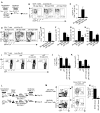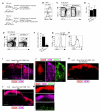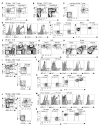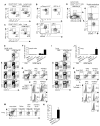T Follicular Helper Cell Plasticity Shapes Pathogenic T Helper 2 Cell-Mediated Immunity to Inhaled House Dust Mite
- PMID: 26825674
- PMCID: PMC4758890
- DOI: 10.1016/j.immuni.2015.11.017
T Follicular Helper Cell Plasticity Shapes Pathogenic T Helper 2 Cell-Mediated Immunity to Inhaled House Dust Mite
Abstract
Exposure to environmental antigens, such as house dust mite (HDM), often leads to T helper 2 (Th2) cell-driven allergic responses. However, the mechanisms underlying the development of these responses are incompletely understood. We found that the initial exposure to HDM did not lead to Th2 cell development but instead promoted the formation of interleukin-4 (IL-4)-committed T follicular helper (Tfh) cells. Following challenge exposure to HDM, Tfh cells differentiated into IL-4 and IL-13 double-producing Th2 cells that accumulated in the lung and recruited eosinophils. B cells were required to expand IL-4-committed Tfh cells during the sensitization phase, but did not directly contribute to disease. Impairment of Tfh cell responses during the sensitization phase or Tfh cell depletion prevented Th2 cell-mediated responses following challenge. Thus, our data demonstrate that Tfh cells are precursors of HDM-specific Th2 cells and reveal an unexpected role of B cells and Tfh cells in the pathogenesis of allergic asthma.
Copyright © 2016 Elsevier Inc. All rights reserved.
Figures







Comment in
-
Snapshots of CD4+ T cell plasticity in the pathogenesis of allergic asthma.J Thorac Dis. 2016 Sep;8(9):E1010-E1012. doi: 10.21037/jtd.2016.08.19. J Thorac Dis. 2016. PMID: 27747048 Free PMC article. No abstract available.
References
-
- Baumjohann D, Preite S, Reboldi A, Ronchi F, Ansel KM, Lanzavecchia A, Sallusto F. Persistent antigen and germinal center B cells sustain T follicular helper cell responses and phenotype. Immunity. 2013;38:596–605. - PubMed
Publication types
MeSH terms
Substances
Grants and funding
LinkOut - more resources
Full Text Sources
Other Literature Sources
Medical
Molecular Biology Databases

